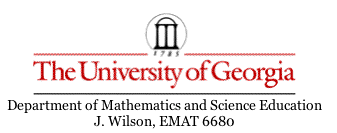

The internal angle bisectors of triangle ABC are extended to meet the circumcircle at points L, M, and N respectively. Find the angles of triangle LMN in terms of the angles A, B, and C.
To begin to set up for this problem, we first need to construct a triangle and its circumcircle. This can easily be done by using the GSP tools created for assignment five.
Now we need to construct the angle bisectors of points A, B, and C. Where these lines meet the circumcircle, call these points N, M, and L. Hence we have the following:

We want to find angle NML, angle MLN, and angle LNM in terms of angle ABC, angle BAC, angle ACB.
First, we know that angle ACB is divided into equal parts by ray CN. This means angle ACN is equal to angle NCB. Also, angle CAN is equal to half of angle ACB. Similarly, angle NCB is equal to half of angle ACB.
Now we must remember that the measure of chord in a circle is twice the measure of the inscribe angle of that cord. This means that cord BN is equal to double angle NCB. Also since angle NCB is equal to half of angle ACB, then double angle NCM is equal to angle ACB. Hence, cord BN is equal to angle ACB. Similarly, we can show that cord BL is equal to angle BAC.
We know that cord NL is equal to double angle NML. So cord NL is equal to cord BN and cord BL. So then double angle NML is equal to cord BN and cord BL. Using the earlier findings, we can then say double angle NML is equal to angle ABC plus angle BAC.
We can then repeat the proof above to show that: Double angle MLN is equal to angle ACB plus angle ABC and that double angle LNM is equal to angle BAC plus angle ABC Thus we get the following:
Do your results hold only for acute triangles?
This can be done by using GSP to check if the angle measurements still work by using the angle measurement command.
First we look at the acute case using the GSP method to check our solution:

Hence our solutions works here.
Now, will look at the obtuse triangle case:

Since our solution still holds.
Lastly, we will look at the right triangle case:

Again, since our solution still holds.